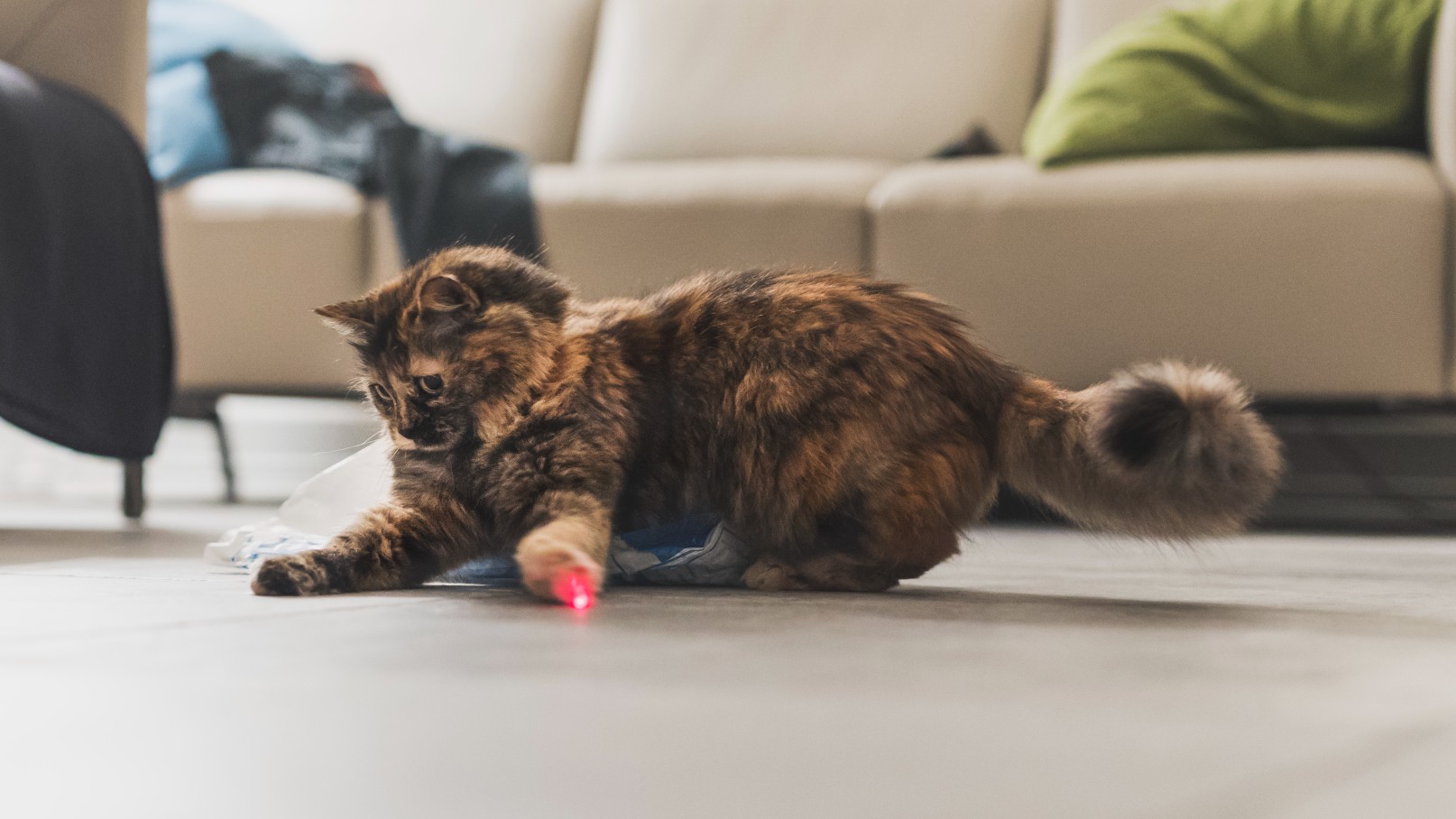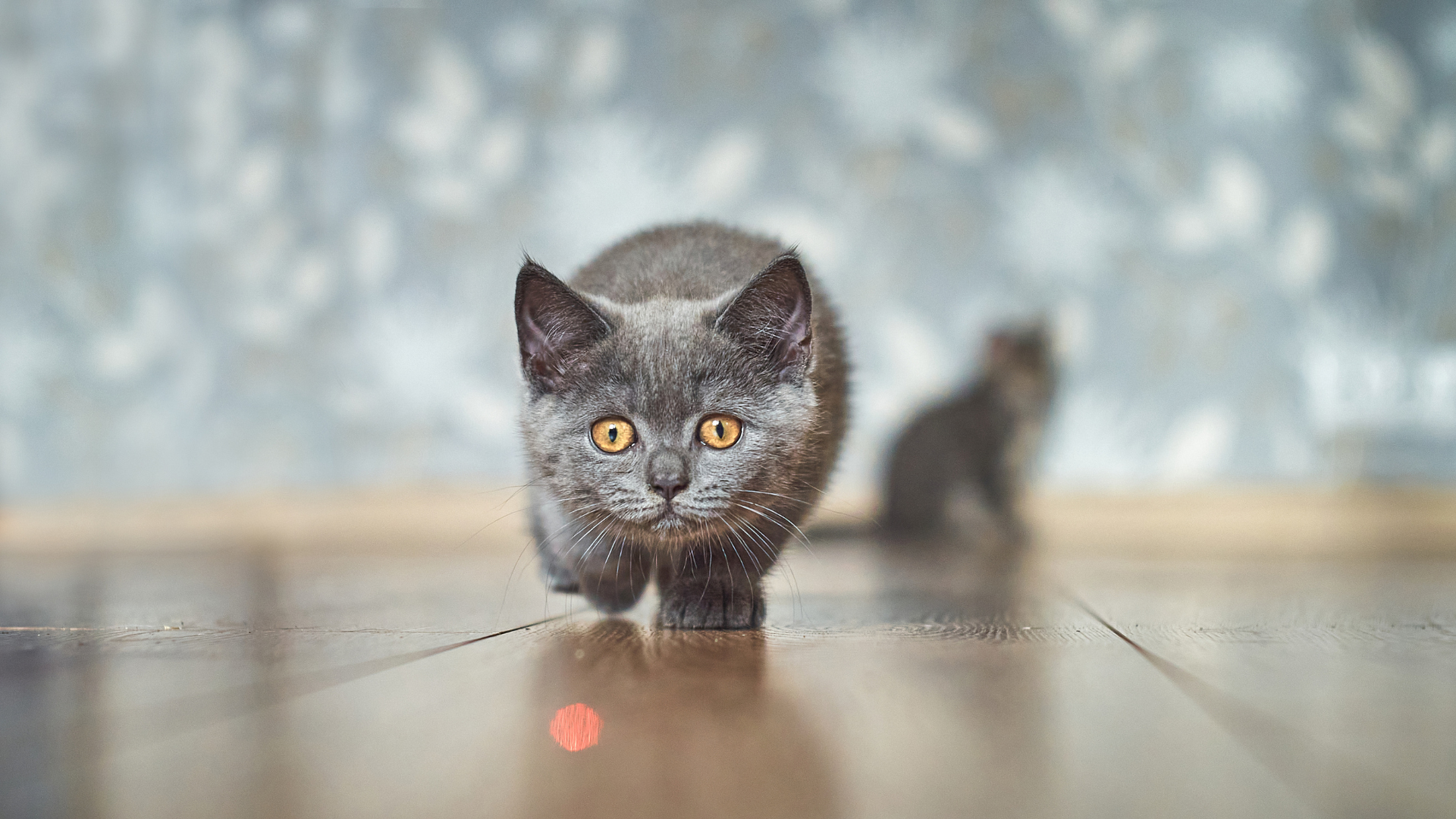'It can feel like a game they never win': A vet shares the real risks of laser pointers for your cat
Are laser pointers bad for cats? Six things to consider before using one

If you’re on the hunt for the best cat toy, you might be wondering, “Are laser pointers bad for cats?” There’s been a lot of debate and conflicting information about whether they’re OK to use, so we’ve called in the experts to settle it once and for all.
Nothing excites a cat like the best automatic laser toys, so it feels like a shame to give them up altogether – but are they safe? While there are some risks to keep in mind, laser pointers aren’t inherently bad for cats as long as you use them the right way.
Below, Dr. Rebecca MacMillan reveals the dangers, the benefits, and how to use them correctly without causing any harm. She’s a vet with more than 16 years of experience and is here to help you decide if laser toys are right for your cat.
Are laser pointers bad for cats?
When used correctly and in line with the manufacturers instructions, laser toys are both fun and stimulating, providing your kitty with a vital source of physical and mental enrichment. That being said, there are risks to laser toys that are worth being aware of.
Risks of laser pointers:
1. The strength of the laser
Did you know that the light from a laser pointer can burn the tissue in the back of the eye known as the retina? It’s true! According to the American Academy of Ophthalmology, the higher the light’s wattage, the more likely it is to cause damage. That’s because once the power output of a laser exceeds five milliwatts, the eye loses its ability to blink, meaning it can’t look away.
“The natural protective mechanisms of the eye – such as the blink reflex – are ineffective against lasers with an output power greater than five milliwatts, and severe retinal damage may occur, even after momentary exposure.”
Get the best advice, tips and top tech for your beloved Pets
To avoid doing damage to your cat’s vision, stick to low-wattage laser toys with a maximum power output of five milliwatts.
Dr. MacMillan says: "A concern of many pet owners is causing damage to their cat’s eyes. Most laser pointers for cats are not strong enough to cause problems, but if you accidentally use a high-powered alternative then it definitely could."

2. Too much activity
While exercise and play are super important for your cat’s health, if you have an older feline or one who has health issues or is very sedentary, don’t overwork your cat by going too fast too soon with the speed of the laser toy. Start slowly and then gradually increase, giving your kitty a chance to get used to their new plaything.
Dr. MacMillan says: "Because laser pointers are so irresistible to cats there is also a risk of them overdoing it. Cats are designed for short bursts of activity rather than continued strenuous exercise. If your cat is usually sedentary, overweight, or suffers from joint disease then they are even more at risk of overexertion, and playtime with laser pointers needs to be managed carefully."
3. The potential for loss of confidence
Believe it or not, laser toys can actually be bad for a cats mental health if they’re never able to ‘catch’ the laser beam successfully. If you’ve ever played a game that you can never seem to win, you know that’s not a fun experience and the same is true for our feline friends. It’s important they get the opportunity to ‘win’ their laser game from time to time as not only will this keep them interested but it’s great for building confidence.
Dr. MacMillan says: "Actually, the main issue we see with cats and lasers is feelings of frustration. While cats enjoy the chase, their reward is in making a physical catch at the end. With laser pointers, there is no ‘kill’ at the end of playtime, so it can feel like a game they never win. In some cats, this will lead to feelings of anxiety and stress."

Benefits of laser pointers for cats:
1. Reduces boredom
Is your cat bored? If you’re out of the house quite a lot or just don’t have as much time to play with your cat as you might like, investing in a laser toy can be a great way of helping to reduce boredom in those times when you’re not available. Bored cats can often get up to mischief and become destructive, so a laser toy is ideal for keeping them occupied and amused.
SmartyKat Feline Flash Laser Pointer Cat Toy | Chewy
If you’re looking for a laser toy that’s under 5mW, we recommend this option by SmartyKat that’s made specifically for cats. It comes with a satisfaction guarantee to give you reassurance, and the outer casting is made from recycled plastic.
2. Helps with weight loss
Obesity is one of the most frequently diagnosed health issues in our fur babies and regular cat exercise is vital for helping to assist with healthy weight loss for cats. Laser toys offer an outstanding physical workout because your cat is constantly on the move, so if you have an indoor cat who’s largely sedentary, a few sessions each day with a laser toy can really help them to shed those unwanted pounds.
Dr. MacMillan says: "Laser pointers are a great exercise tool and seem to get even the laziest of cats moving! The small, quick, and erratic movements that can be made with a laser pointer, closely replicate those made by prey animals. This brings out your cat's natural hunting instincts and gets them engaged."
3. Boosts mental health
Just like us, cats can suffer from low mood, depression and anxiety when they don’t have enough enriching activities to amuse themselves with. Laser toys are brilliant for keeping your kitty’s mind sharp and giving them something interesting and stimulating to engage with. If you’re at all worried about your cat’s mental health, our vet’s piece ‘is your cat sad?’ delves deeper into this issue and offers a range of helpful tips on how to manage depression in cats.

4. Increases bonding
While a huge range of laser toys are automatic, meaning your cat can use them independently without you needing to be there to turn the toy on and off, they’re also great for strengthening the bond you and your feline friend share.
In fact, deepening the relationship between you and your cat is one of the main reasons why cat play is so important. But, it’s not just your relationship that can improve by using laser cat toys, if you have a multi-feline home, investing in toys that your cats can use together can really help cement their fur baby friendship.
Dr. MacMillan says: "Laser pointers play can also be a great way of bonding and strengthening the relationship you have with your cat. They are an easy toy for busy or tired owners to use when they need to get their cats moving about."
How to use a laser pointer with your cat
As you can see, there are a range of physical and mental health benefits to using laser pointers that make them well worth having in your feline friends toy box.
The pros of laser pointers far outweigh the cons when this beneficial toy is used correctly, here’s a few safety tips to help minimize the risks and make play time more enjoyable:
Dr. MacMillan says: "You will need to introduce playtime slowly and keep exercise sessions short, especially if your cat is sedentary or has mobility issues. It is important to take care when aiming your pointer.

"Getting your cat to jump too high, slide on a slippery floor, or twist awkwardly could cause injury. Carelessly aiming the laser at shelves or near priceless ornaments could lead to broken possessions and injured kitties. So, make sure that you always concentrate on where you are directing your laser pointer and make sure you are playing in a safe space.
"You must not shine a laser in your cat's eyes, as even if the frequency is not high enough to injure your cat, as it is still unpleasant and they could become dazzled. To avoid frustration, always end play sessions with a physical toy so that your cat feels like they have won the game. Shine the light on a toy or treat before quickly turning it off when your cat pounces."
It’s a good idea to be on hand to monitor the first time your cat uses their laser toy as that way you’ll be able to gauge whether or not this is the right toy for them. Most cats love chasing laser beams, but there’s always the odd feline who’s not that keen.
If that’s the case, you might like to check out our guide to the best automated cat toys which offers a range of other interactive options that are just as fun and may be more to your cats liking.
What is laser pointer syndrome in cats?
Dr. MacMillan says: "Laser pointer syndrome is when a cat becomes fixated on chasing lights, shadows, and reflections. This usually happens when they are overstimulated and constantly on the lookout for the red laser dot. To try and stop this from happening you should make sure your cat has a wide variety of toys and regularly engages in other types of play. Plenty of positive attention from you will also help your cat feel more relaxed."
You might also want to read: Why do cats chase lasers? and the best cat toys for indoor cats.

Rebecca is a veterinary surgeon who graduated in 2009 from the Royal Veterinary College in London. She has a wealth of experience in first opinion small animal practice, having done a mixture of day-to-day routine work, on-call emergency duties and managerial roles over the years. Rebecca enjoys medicine in particular and she is proud to have recently achieved a BSAVA postgraduate certificate in small animal medicine (with commendation).
This page was last updated on February 20 by Megan Milstead.
Edited by Georgia Guerin.

Kathryn is a freelance writer who has been a member of the PetsRadar family since it launched in 2020. Highly experienced in her field, she's driven by a desire to provide pet parents with accurate, timely, and informative content that enables them to provide their fur friends with everything they need to thrive.
Kathryn works closely with vets and trainers to ensure all articles offer the most up-to-date information across a range of pet-related fields, from insights into health and behavior issues to tips on products and training.
When she’s not busy crafting the perfect sentence for her features, buying guides and news pieces, she can be found hanging out with her family (which includes one super sassy cat and a kitten), drinking copious amounts of Jasmine tea and reading all the books.
She has written for a range of publications, including Fit&Well, Top Ten Reviews, LiveScience, Goodto, and Product Hunt.
- Dr. Rebecca MacMillanVet
- Megan MilsteadStaff Writer

